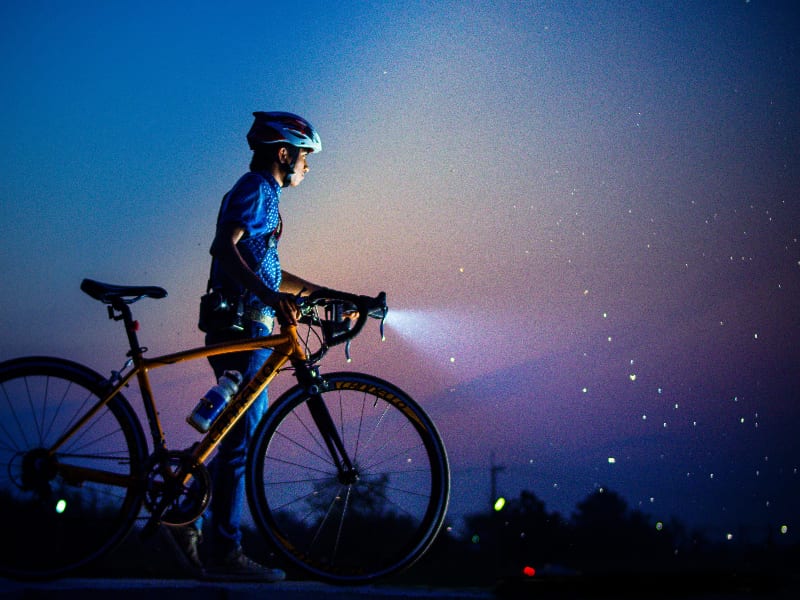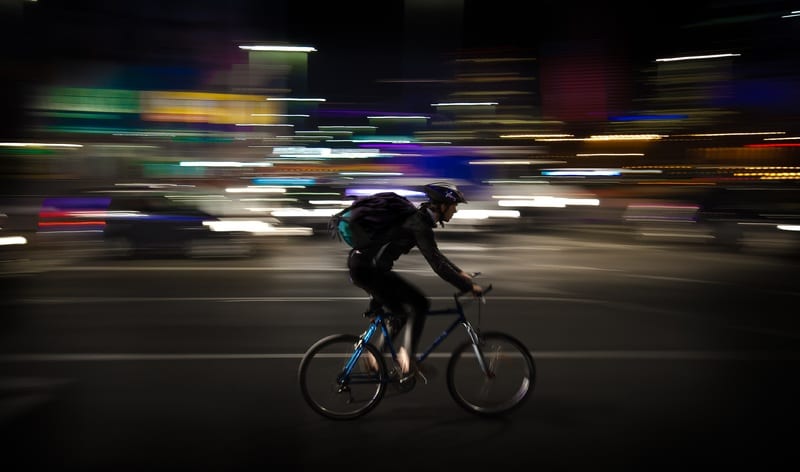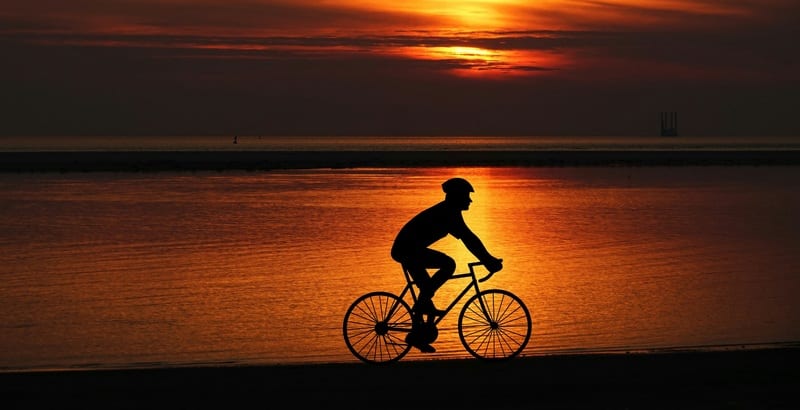Last Updated on 29 September 2023 by Cycloscope
Night Cycling: 4 Tips to Ride Your Bike Safely in the Dark
Need to ride a bike at night for commuting, or just want to do some night cycling to enjoy the silence? Here are 4 tips to stay safe while biking in the evening
Riding your bicycle as a means of transportation is a great way to get some exercise and reduce your carbon footprint.
But with all the good things that it does for you and the environment, it also comes with a few risks, especially if you have to bike at night.
A night bike ride can be a great idea: the silence, the quiet roads, the cool temperatures – these and more factors can concur in making cycling at night a really soothing experience.
Of course for some of us is not a sought pleasure, but more of a necessity – I’m thinking of all these heroic bike commuters that every winter day need to cycle in the evening.
An evening bike commuting can indeed be more dangerous than a night ride, as evenings are busy times on the road with motorists coming back home from work.
So either your bike ride is for pleasure or for duty, either you’ll be cycling in the evening or in the darkest hours of the night… let’s look at some things you can do to ensure you stay safe on a night bike ride, then you can read our article about the brightest bike light in 2023.
1. Light it up

One of the challenges of night cycling is visibility. Your bike (and by extension, you) are less likely to be noticed because bikes do not have any lights, unlike cars.
If you need to bike at night, you should have at least a front and backlight attached to your bike. Ideally, you want your headlamps shining fixed on the road a few feet in front of you, while tail lights should be flashing.
Anything from 400 to 800 lumens should be enough on the road, but you might want something more if cycling in the darkest lanes with no road lines, or on off-road trails.
Also speed is an important factor when on a night bike ride, the faster you’re going the more powerful should be your bike light. In all cases, you should have a red rear light.
Be careful though when using powerful bike headlights, you could dazzle the oncoming driver, which can cause him/her to lose control of the vehicle, a potentially very dangerous situation.
Night cycling safety tip: You may also want to attach lights on your ankles when you bike at night. Other drivers are more likely to notice your presence if they can track your movement as you pedal. Check this glowing ankle band on Amazon!

2. Obey the rules of the road
The thing about riding a two-wheeled vehicle is that it often gives us a false sense of superiority; that cyclists do not really need to obey the basic rules and law since they’re not motorized.
Some cyclists feel that they are invincible, which is the reason why you see cyclists weave in and out of traffic, or ignore traffic lights; using their mobility and size to their advantage.
This mentality is what often causes many cyclists to fall victim to accidents. As much as possible, obey traffic laws and stick to bike lanes.
Try to avoid fitting yourself into small spaces, which is a common behavior among cyclists. You may get clipped by passing cars, especially since they might not be able to see you clearly.

3. Wear reflective gear
As mentioned earlier, visibility is one of the main concerns when it comes to night riding. A lot of drivers who end up causing injury to a cyclist will say that they did not see the biker because of how dark it was.
This is why a lot of bicycles nowadays come equipped with retro-reflective surfaces to make bikes easier to see at night.
You can further up your visibility by wearing the right gear. It’s one thing to wear bright colors during the day, but that won’t cut it if you’re riding at night.
Aside from wearing a bike helmet, wearing bike gear with reflective surfaces will ensure that you are safe and that your bike is visible to other vehicles in the evening dusk, and dark.

4. Familiarize your route
It’s nice to take the road less traveled and explore new routes when biking during the day, but when you’re riding at night you may want to stick to the familiar.
Using the route you know best and that you’re sure is the safest available is the best practice when cycling at night.
This way you avoid getting into trouble because there are no bike lanes or proper lighting on the route you took, or because you got lost.
Riding your bicycle at night can be very scary and dangerous compared to riding during the day, but being prepared for a night ride will go a long way to making sure that you are safe and that your experience is a fun and enjoyable one.
5. Take your space
When riding your bike at night you should be sure upcoming motorists can spot you quickly. When a cyclist rides on the very side of the road in the dark, it’s likely to be left out of the car headlights’ range.
Taking your space, something like a meter towards the middle of the road, not only makes you more visible but also asserts your presence on the road and gives you more space to fall in, in case of a crazy or distracted motorist passing too close to you.
6. Get a spare light
What would happen if your bike headlight fails in the middle of a night ride? How will your reach back home in complete darkness?
Even the best bike lights can fail, so it’s always a good idea to have a b-plan at hand.
I personally love to bring a bright camping headlamp, those that are worn on your head. They are very useful and versatile: for example when repairing a flat or checking out any mechanical issue.
FAQ about night cycling
Is it Safe to Ride at Night?
Yes and No. If you are properly equipped with lights, reflective gear, bike helmet and respect the rules of the road it is safe. Check our suggestions and bike equipment list. Of course, it also depends on what kind of roads are you cycling.


